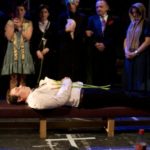(This post continues my meander through Matthew Crawford’s Shop Class as Soulcraft. Two posts precede it, here and here.)
I found Soulcraft especially illuminating in its third lesson, that manual work connecting us to material reality. Crawford draws out the risks of absorption, not only with oneself, but also with a task in hand. Those who take the first route he labels The Idiot – utterly disinterested in the workings of the outside world; unsurprisingly, he’s not fan. The second, he sees as The Curious – one who must follow one thing through to its full conclusion, irregardless of wider concerns. This is a pitfall, or at best a stepping-stone, not a desired state of being. If I, as a recovering Idiot, learn to whittle, learn to love whittling, and whittle all day through, then in Crawford’s eyes I haven’t addressed my habit of indulgent absorption – I’ve merely shifted its subject. And this is what manual work – rather than a manual obsession that exists for its own sake – allows us to transcend. Work has an object, in the form of a customer, or a project. It introduces competing demands, a wider context: Mrs Roberts may want a carved ashtray, but she can’t afford much for it and needs it by Wednesday, so I’ll forego my indulgence in the wood for a wider appreciation that includes the wood, Mrs Roberts, and the value of my time.
This is an ongoing struggle, rather than an end-state: in Crawford’s words, “being a clear-sighted person who looks around and sees the whole situation…is something that needs to be achieved on a moment-to moment basis”. There’s a call to betterment there that fits snugly with a variety of spiritual practises, from eastern approaches anchored with meditation through to the Christianity of CS Lewis, and it also resonates with current trends towards mindfulness that recognise the importance of the everyday. To become this individual, who transcends themselves through curiosity, and transcends narrowness through context, allows you to transcend alienation and become fully enabled, ready to take on the world as is. And against the vein of individualism that I read into the text, Crawford agrees our choices in making and doing only gain meaning by how they are measured to the needs and demands of others.
Reading back, I wonder what Crawford and David K Reynolds would make of each other. Reynold’s Constructive Living framework, based partly on Morita therapy and further back into Zen, focuses on immediate connection with the world itself, as it offers itself to you right now. It charges us to undertake every activity with full attention and awareness, eschewing self absorption and neurotic concern. Inspired by its other source of Naikan practise (itself from Shin Buddhism), it focuses attention on gratitude towards and concern for the needs of others, appreciating at the greatest level possible the web of human context that makes any action possible (such as the manifold steps that get an item into our hands for use). And his Handbook for Constructive Living emits a certain unsentimentality and gloves-off attitude that Matthew Crawford might approve of.
I’ll call a halt on this, as I could talk and talk and talk. Particularly on how this is the foundation for improvisational theatre, how improv itself is a training regime for connection with the moment, connection with the real (it may be perverse to say so for a form full of mime and invention, but it’s true), connection with one another. Another time. I’m aware also that picking Reynolds to contrast may seem chauvinist, given that explorations of interconnectivity and groundedness are a rich space of feminine discourse. But that’s partly my point: Soulcraft feels to me as a very masculine exploration of these topics, and it’s important to recognise this, for what it adds and how it may be limited. To balance this a touch and in fairness to Crawford, I’ll close with a few quotes he takes from Iris Murdoch in support of his argument. Murdoch states that “anything which alters consciousness in the direction of unselfishness, objectivity and realism is to be connected with virtue”; putting it another way, “virtue is the attempt to pierce the veil of selfish consciousness and join the world as it really is”. Which we can do by following our hands.
The three lessons – agency, endeavour and a wider awareness of our position in the world – map very well onto Martin Seligman’s three kinds of happiness. The pleasant life, accessing the things you want to be comfortable and experience pleasure, is massively supported by having economic freedom and unburdening yourself of helplessness and stresses. The engaged life, experiencing flow and identity with your activities, clearly arises from physical endeavour, which is often used as an exemplar of engaged activity. And the meaningful life, of being part of something bigger than you, is served by a wider awareness of the web of life within which we are engaged, both moment-to-moment and at a social level of obligation and giving.
Bibliography and Links
Matthew Crawford (2009). Shop Class as Soulcraft. Penguin Press. Link
David K Reynolds (1995). A Handbook for Constructive Living, Morrow, N.Y. Link
David K Reynolds’ site
Morita therapy and Naikan on Wikipedia
Martin Seligman’s site
